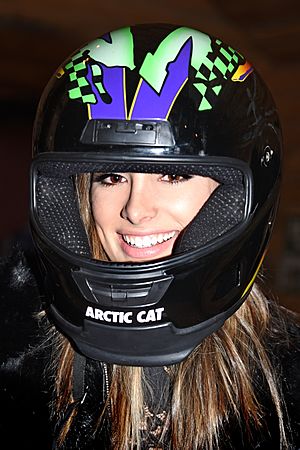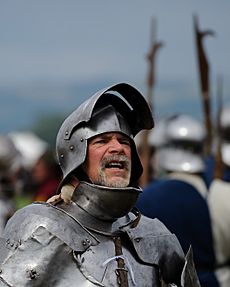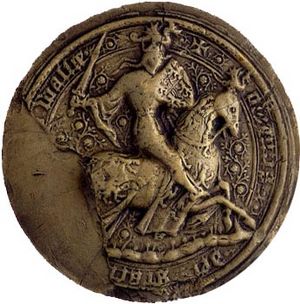Helmet facts for kids
A helmet is a hard or cushioned hat which is worn to protect a person's head. There are many different types of helmets. Some helmets are made from metal. Other helmets are made from plastic. Helmets often have fabric cushions inside and fabric straps to hold the helmet on a person's head.
Types of helmets
Soldiers wear steel helmets to protect their heads from explosions and bullets. Construction workers wear plastic helmets to protect their heads from falling objects. Welders wear special helmets with a lens that lets less light through. This protects their eyes from the bright light of welding. Bicycle riders wear plastic and foam helmets to protect their heads in case they have an accident. Motorcycle riders wear helmets to protect their heads in case they have an accident. People who ride horses often wear helmets, to protect them if they fall off the horse. People who rock climb wear helmets in case they fall. Cavers wear helmets to protect their heads from bumping into rocks in a cave.
Design
Helmets attempt to protect the user's head by absorbing mechanical energy and protecting against penetration. Their structure and protective capacity are altered in high-energy impacts. Beside their energy-absorption capability, their volume and weight are also important issues, since higher volume and weight increase the injury risk for the user's head and neck. Anatomical helmets adapted to the inner head structure were invented by neurosurgeons at the end of the 20th century.
Helmets used for different purposes have different designs. For example, a bicycle helmet must protect against blunt impact forces from the wearer's head striking the road. A helmet designed for rock climbing must protect against heavy impact, and against objects such as small rocks and climbing equipment falling from above. Practical concerns also dictate helmet design: a bicycling helmet should be aerodynamic in shape and well ventilated, while a rock climbing helmet must be lightweight and small so that it does not interfere with climbing.
Some helmets have other protective elements attached to them, such as a face visors or goggles or a face cage, or an ear cage or ear plugs and other forms of protective headgear, and a communications system. Sports helmets may have an integrated metal face protector (face cage).
- Baseball batting helmets have an expanded protection over the ear, which protects the jaw from injury.
- Motorcycle helmets often have flip-down face screens for rain and wind protection, and they may also have projecting visors to protect the eyes from glare.
- Hard hats for construction workers are worn mainly to protect the wearer from falling objects such as tools.
- Helmets for riot police often have flip-down clear visors and thick padding to protect the back of the neck.
- Modern firefighter's helmets protect the face and back of the head against impact, fires and electricity, and can include masks, communication systems, and other accessories.
- Welding helmets protect the eyes and face and neck from flash burn, ultraviolet light, sparks and heat. They have a small window, called a lens shade, through which the welder looks at the weld; for arc welding this window must be much darker than in blowtorch goggles and sunglasses.
- People with some medical conditions must wear a helmet to protect the brain, due to a gap in the braincase, e.g. because of cleidocranial dysostosis or in separated craniopagus twins.
- Mixed martial arts helmets have ear pads to prevent serious injuries to the athletes, who do not usually endure such force to the ears.
- Some watersports helmets, such as for underwater hockey or water polo, have ear-cages fitted which are designed to help prevent burst eardrums caused by an excessive water pressure resulting from a contact or percussion from other equipment involved in the sport.
- Crash helmets for F1 racing drivers, their design and construction have evolved enormously. Nevertheless, head and neck trauma remains the greatest single injury risk to drivers.
Materials
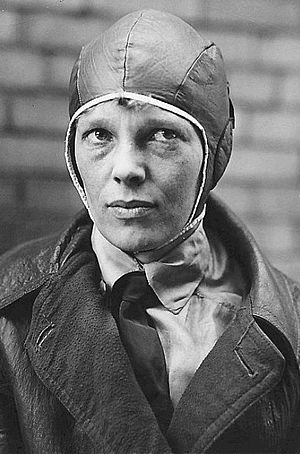
Historically, helmets have been made from a wide range of materials, including various metals, plastics, leather, and even some fibrous materials such as Kevlar. Ancient and medieval helmets were usually made of metals, often bronze, iron or steel, though some boar's tusk helmets were known to ancient Mycenae.
Some British gamekeepers during the 18th and 19th centuries wore helmets made of straw bound together with cut bramble. Developed in the mid-19th century, the pith helmet, made of pith or cork, was often worn by Europeans in the tropics.
Military applications in the 19th-20th centuries saw a number of leather helmets, particularly among aviators and tank crews in the early 20th century. In the early days of the automobile, some motorists also adopted this style of headgear, and early football helmets were also made of leather. In World War II, American, Soviet, German, Italian and French flight crews wore leather helmets, the German pilots disguising theirs under a beret before disposing of both and switching to cloth caps. The era of the First and Second World Wars also saw a resurgence of metal military helmets, most notably the Brodie helmet and the Stahlhelm.
Modern helmets have a much wider range of applications, including helmets adapted to the specific needs of many athletic pursuits and work environments, and these very often incorporate plastics and other synthetic materials for their light weight and shock absorption capabilities. Some types of synthetic fibers used to make helmets in the 21st century include Aramid, Kevlar and Twaron.
Helmet types
Helmets of many different types have developed over the course of human history. Most early helmets had military uses, though some may have had more ceremonial than combat-related purposes.
Two important helmet types to develop in antiquity were the Corinthian helmet and the Roman galea.
During the Middle Ages, many different military helmets and some ceremonial helmets were developed, almost all of these being made of metals. Some of the more important medieval developments included the great helm, the bascinet, the frog-mouth helm and the armet.
The great seal of Owain Glyndŵr (c. 1359 – c. 1415) depicts the prince of Wales & his stallion wearing full armour, they both wear protective headgear with Owain's gold dragon mounted on top, this would have been impractical in battle so therefore these would have been ceremonial.
In the 19th century, more materials were incorporated, namely leather, felt and pith. The pith helmet and the leather pickelhaube were important 19th century developments. The greatest expansion in the variety of forms and composition of helmets, however, took place in the 20th century, with the development of highly specialized helmets for a multitude of athletic and professional applications, as well as the advent of modern plastics. During World War I, the French army developed the Adrian helmet, the British developed the Brodie helmet, and the Germans produced the Stahlhelm.
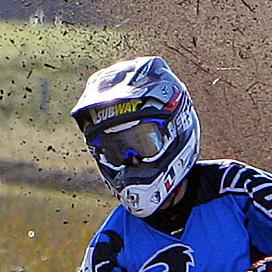
Flight helmets were also developed throughout the 20th century. A multitude of athletic helmets, including football helmets, batting helmets, cricket helmets, bicycle helmets, motorcycle helmets and racing helmets, were also developed in the 20th century.
Helmets since the mid-20th century have often incorporated lightweight plastics and other synthetic materials, and their use has become highly specialized. Some important recent developments include the French SPECTRA helmet, Spanish MARTE helmet or the American PASGT (commonly called "Kevlar" by U.S. troops) and Advanced Combat Helmet, or ACH.
Images for kids
See also
 In Spanish: Casco para niños
In Spanish: Casco para niños


